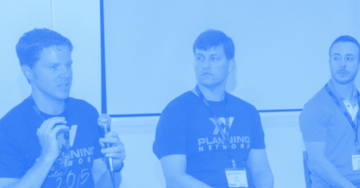Why Financial Planning Conferences Don't Attract Young Advisors - and How FinCon Can Save Them
Share this
Financial planning has an age problem. We have more CFP’s over 70 than under 30.
One of the most effective ways to engage young advisors is conferences, and yet the current slate of conferences is deteriorating to a point that it's just sad. It's difficult to find a conference with enough young advisors to fill a table, much less a room.
A recent trip to FinCon made us realize what must change in order to save financial planning conferences. We only hope that conference organizers will read this post with an open mind, because “the way it’s always been done” simply isn’t working any longer.
This should serve as a starting point, a basic guide, to attracting young advisors to financial planning conferences.
What FinCon (and Its Organizers) Gets So Right
If you haven’t yet heard of FinCon, is it the annual conference for financial bloggers, writers, media members, and planners. The tagline, “Where Money and Media Meet,” does a wonderful job of summarizing its mission.
With four conferences under the belts of the organizers, the conference has seen 50%-100% growth year after year and should be the envy of financial planning conference organizers. The attendees are incredibly passionate about the conference and help to grow the event every year.
What makes FinCon so different? Here are a few takeaways from our recent trip to New Orleans:
1. The Cost
The cost of attending financial planning conferences has gotten out of hand in recent years. Here is a breakdown of the flagship conferences for FPA and NAPFA this year:
FPA Retreat 2015:
- Conference Registration: $1,049 - $1,349
- Hotel: $214/night
- Flight to Atlanta (Average): $404
- Total Cost for 3 Nights: $2,095- $2,395
NAPFA National Fall 2014:
- Conference Registration: $795 - $1,395
- Hotel: $189/night
- Flight to Charlotte (Average): $433
- Total Cost for 3 Nights: $1,795 - $2,395
Now let's take a look at the cost to attend FinCon.
FinCon 2014:
- Conference Registration: $199 - $499
- Hotel: $139/night
- Flight to New Orleans (Average): $358
- Total Cost for 3 Nights: $974- $1,274
And if you're wondering where these numbers came from:
- Conference rate range shows early-bird member rate and full non-member price. FinCon doesn’t have member rates (since they don’t have members), so rates shown are available to all attendees.
- Also note that FinCon just sold 2015 tickets to 2014 conference attendees for $149.
FinCon is UNBELIEVABLY more affordable to attend than conferences hosted by FPA and NAPFA. It's no wonder that it's hard to find young planners at conferences, since they 're either trying to talk their employers into a $2,000+ price tag or trying to justify the expense within their own firm.
One way that many young advisors make conferences cheaper is by sharing hotel rooms. While they can do this at any conference, FinCon makes it easy to do by hosting a shared Google Doc that lists attendees looking for a roommate.
(We split our FinCon room 3 ways, and even though we stayed an extra night the cost broke down to $185/person – that’s less than one night at the other conferences.)
In other words, the organizers and attendees alike are interested and actively trying to make coming to this conference something realistic and affordable for everyone who wants to be there.
Finally, FinCon lets attendees sell their pass at any time, without fees. If for some reason you can’t attend, you simply post your asking price on another FinCon-hosted shared Google Doc and folks will contact you to purchase it.
Key Takeaways on Cost for Organizers of Financial Planning Conferences:
- Find ways to bring down the cost of the conference pass
- Host in cities that have inexpensive flights and use hotels with lower rates
- Facilitate attendees finding roommates to keep their hotel costs lower
- Facilitate the selling of conference passes for those that can’t make it
2. The Content
FinCon has a major advantage over most financial planning industry conferences. They have a very tight niche market and therefore their content can be highly focused.
As young advisors, most industry conferences have 2 to 3 sessions that are applicable to our work as planners who work virtually with Gen X & Gen Y clients. Paying over $2,000 to attend a few applicable sessions, and taking naps during the “economic outlook” sessions hosted by speakers that paid a sponsor fee to be there, isn’t a very good use of funds.
The problem for major industry conferences is they try to serve all financial advisors, and therefore the content is so varied that it serves no one.
The keynote presenters at this year’s FinCon were phenomenal. The first official day of the conference opened with Jeff Goins and the second day opened with Chris Ducker. The whole event and closed with a dance party hosted by PT Money (the founder of FinCon) and every speaker seemed to understand the audience and connected their content with those attendees.
Another major bonus for FinCon is there aren't any sponsored sessions (other than at meals) so you know all the content is educational and not a sales pitch. Rest assured that when someone pays $7,000 to speak at a breakout session, they'll do their best to cover their expenses by selling instead of educating.
And the content at FinCon was remarkably actionable. There wasn’t a session we walked away from thinking, “that was great information, but what do I do with it?” Speakers educated on niche topics, such as podcasting, writing a book, building a website, etc., and attendees walked away knowing how to implement the recommended changes.
Financial planning conferences are so focused on providing CE to planners that they forget to focus on content that's highly actionable and makes the conference trip worth the cost. We're still lost as to why financial planning conferences feel the need to pack their agenda with CE, instead of focusing on practical content that attendees can actually use.
Yes, financial planners do need CE -- but it can be obtained for free online. We don’t need to pay $2,000 for a few CE credits. Attendees pay money for actionable and practical content, and to network with other financial advisors to learn from them.
Key Takeaways on Content for Organizers of Financial Planning Conferences:
- Target the conference to a niche market to increase attendance of target audience and allow for more rich content
- Drop the “pay to play” sessions and instead focus on great educational content to bring in more attendees
3. The Agenda
Financial planning conferences are very predictable. You show up the night before, breakfast starts a 7:00am, there is a keynote, some 50 minute breakouts, another keynote, more 50 minute breakouts, and then the occasional 75 minute panel presentation.
The only question is, how many simultaneous breakouts will we have? FinCon set up a very different agenda, and it's part of what made the whole event so great.
Here are a few of the different types of sessions they hosted throughout the conference:
- Ignite
 – A series of twelve different five-minute presentations, hosted at a bar the night before the conference officially started. Each presentation had twenty slides, and moved automatically every fifteen seconds forcing the speaker to stay on track. It's a really fun format.
– A series of twelve different five-minute presentations, hosted at a bar the night before the conference officially started. Each presentation had twenty slides, and moved automatically every fifteen seconds forcing the speaker to stay on track. It's a really fun format. - Pro Networking (i.e. professional speed dating) – Attendees and vendors had twelve ten-minute time slots to meet with folks they really wanted to be sure they connected with while at the conference. Prior to the conference, they were able to see a list of other attendees and schedule a time to talk. In two hours, attendees met twelve people that they really wanted to talk to and it really started the conference off on the right foot. This was a huge bonus to brands and sponsors, since we really wanted to meet with other sponsors and talk about partnership opportunities.
- Blog Mentor Program – FinCon connected attendees with successful bloggers to review their websites. You could sit down (for free) with a blogger that you really respect and have them help you improve your website to attract more readers, and convert readers into subscribers.
- Website Reviews – You could attend a session where a professional marketer would go through a site and basically rip it apart (think the red ink treatment from your high school English teacher). The result? A ton of wonderful education on what makes a website successful, and what cause them to fail.
Key Takeaways on the Schedule and Agenda for Organizers of Financial Planning Conferences:
- Add in a variety of session formats to keep the agenda interesting
- Facilitate one-on-one and group hands on learning sessions
- Facilitate brand-to-brand networking, along with attendee-to-attendee networking, through a speed dating format
4. Relaxed Attire (and Atmosphere)
 When I started my own firm, I committed to never wearing a tie to a professional event and threw away all of my suits. (To be fair, I lost 30 lbs so they didn’t fit anyways.)
When I started my own firm, I committed to never wearing a tie to a professional event and threw away all of my suits. (To be fair, I lost 30 lbs so they didn’t fit anyways.)
I now wear jeans and an #XYPN t-shirt to conferences, and get some really awkward looks and comments. I’m also rockin’ a Montana-style beard, and get some really interesting comments like “when did you go with the homeless look?” and “how did you reproduce with that thing on your face?” (I have a 9 week old.)
The truth is, I’m most comfortable in jeans and a t-shirt, and have a beard because I want to. I don’t understand why this is odd at professional conferences -- especially after experiencing FinCon.
At FinCon, everyone is in jeans, t-shirts, and flip-flops. While you see the occasional suit, it is because that’s what the attendee wanted to wear… not what they were expected to wear. (And in fact, our content manager who was also in attendance overheard two sponsors that came from a mortgage company talking about how awkward they felt wearing their suits all weekend!)
When you're sitting at a conference all day, for multiple days in a row, people want and need to be comfortable. Having conference organizers promoting a relaxed dress code would go a long way towards making conferences a more relaxed and enjoyable experience.
Key Takeaways on Attire and Atmosphere for Organizers of Financial Planning Conferences:
- Promote a relaxed dress code for attendees
- Consider having organizer staff in casual clothing to help encourage attendees to relax and be comfortable
5. Sponsors and the Exhibit Hall
Conference funding is largely driven by the list of sponsors that choose to support and promote at the event. Most financial planning conferences sell exhibit booth space, then make add-ons available such as sponsor logo on promotional materials, breakout sessions with a speaker from sponsor company, happy-hour/meals, and so on.
The starting price point for conference exhibit halls can be $7,000 -- and this doesn’t include additional expenses such as setting up the booth (which can cost thousands of dollars), travel to the conference, etc.
For XYPN to exhibit at a national conference, we would likely spend north of $10,000. This puts sponsorship out of reach for many new companies.
 Even though FinCon boasts more attendees than the majority of financial planning conferences, their sponsorships were much more varied and had a wider range of options at different price points for companies. Exhibit hall space was $1,000, with lower price point options if the sponsor simply wanted to place promotional materials in the conference bag. Costs ranged all the way up to $30,000 for a sponsored meal.
Even though FinCon boasts more attendees than the majority of financial planning conferences, their sponsorships were much more varied and had a wider range of options at different price points for companies. Exhibit hall space was $1,000, with lower price point options if the sponsor simply wanted to place promotional materials in the conference bag. Costs ranged all the way up to $30,000 for a sponsored meal.
The best part? All of the pricing information for each sponsorship opportunity was placed online. (Note that 2015 information has not been added yet; the 2014 conference was just in September and the conference is always held in the fall.)
I’ve never seen another organization post their conference advertising prices in a public domain. If pricing wasn't public, we would always wonder if we were getting the best deal on our sponsorship package -- or if another vendor was able to negotiate cheaper rates.
The wide range of opportunities and price points allowed a variety of brands to participate in FinCon. This made for a really exciting exhibit hall space. Brands as large as USAA and as small as a blog coaching service were in attendance.
The variety of brands (and absence of fund companies) helped drive a lot of traffic through the hall, with the majority of attendees stopping in at some point.
Another major different was when the exhibit hall was actually open. While FinCon spans 2.5 days, the hall was only officially open on one day and there was a sponsored reception in the exhibit hall for 3 hours on that day.
This meant that the booths were staffed all day, but most attendees came through during the 3 hour time period. This helped relieve conference organizers from finding ways of pushing attendees into the exhibit hall every few hours with silly things like “standing lunches with exhibitors” -- which does nothing but make attendees mad. This also meant exhibitors could come in for just the day, which helped keep their costs a little lower since they had fewer nights in the hotel to pay for.
Key Takeaways on Sponsorships for Organizers of Financial Planning Conferences:
- Put advertising/sponsorship rates online and make them accessible publicly
- Create a wide range of sponsorship opportunities so small/new brands can participate
- Restructure time in the exhibit hall to promote higher attendance
6. The Purpose
Ultimately, many of the points discussed in this post are driven by the purpose of the conference.
The last annual budget I saw for the national organizations showed that half of their total annual revenue came from their national conferences. This means that conferences can’t simply break even, but must bring in hundreds of thousands of dollars -- if not millions -- to be considered successful.
FinCon is owned and operated by a single individual who doesn't need to make $1 million off the conference for it to be a success. We believe this points to a valuable discussion this industry needs to have: why the national organizations continue to rely on outdated conference formats for the majority of their revenue. (But, that's a conversation for another day.)
The Bottom-Line Takeaway for Financial Planning Conferences Looking to Learn from FinCon
Changes must be made to the existing conference formats if organizations expect to attract younger attendees. While making the registration fees cheaper for young members is a start (and FPA has been doing this with some of their national conferences), it isn’t enough.
We understand that financial planning organizations can’t simply mimic FinCon and expect to have the same success. But using the guiding principles and tangible examples that are responsible for the success of FinCon would go a long way towards ensuring the future success of the conferences.

About the Author
Alan Moore is the CEO and Co-Founder of XY Planning Network—a support ecosystem dedicated to helping fee-for-service advisors start, run, and grow their own financial planning firms and serve the clients they want. His favorite part about his job is dreaming about possibilities for what's next, knowing his stellar team will either tell him no or Get Sh*t Done to make it happen.
Share this
- Advisor Blog (721)
- Financial Advisors (244)
- Growing an RIA (128)
- Business Development (95)
- Digital Marketing (95)
- Marketing (92)
- Community (82)
- Start an RIA (76)
- Coaching (74)
- Running an RIA (72)
- Compliance (70)
- Client Acquisition (68)
- Technology (67)
- Entrepreneurship (64)
- XYPN LIVE (64)
- Fee-only advisor (49)
- Sales (49)
- Bookkeeping (46)
- Client Engagement (45)
- Practice Management (44)
- XYPN Books (43)
- Scaling an RIA (42)
- Investment Management (41)
- Client Services (31)
- Employee Engagement (31)
- Financial Education & Resources (31)
- Lifestyle, Family, & Personal Finance (31)
- Market Trends (26)
- Journey Makers (24)
- Process (18)
- Niche (13)
- SEO (9)
- Career Change (8)
- Partnership (8)
- Transitioning Your Business (7)
- Sapphire (6)
- Persona (4)
- Transitioning To Fee-Only (4)
- Emerald (3)
- Social Media (3)
- Transitioning Clients (3)
- RIA (2)
- Onboarding (1)
Subscribe by email
You May Also Like
These Related Stories

Go to the XY Planning Network Conference and FinCon 2015 -- for Free
Jan 30, 2015
3 min read

How XY Planning Network is Starting a Movement in Financial Planning
May 7, 2014
5 min read
.png?width=360&height=188&name=WWAS%20(25).png)



.png?width=600&height=400&name=PW%20%20Insider%20Insights%20YT%20Thumbnail%20Image%201920%20%C3%97%201080%20px%20(1).png)